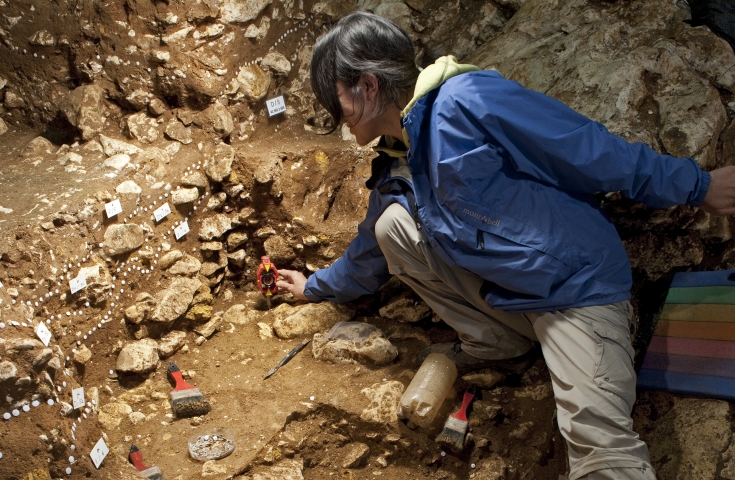Time-travelling mammoths?

Mammoths have been extinct for thousands of years – or have they? A team of researchers led by environmental genomicist Laura Epp at the University of Konstanz found DNA of the prehistoric giants in layers of Siberian lake sediment that were only a few hundred years old. If the findings proved true, they would eclipse all previous research on mammoths and even rewrite a bit of geological history.
However, Laura Epp and her international team paused before celebrating. Something just couldn't be right. Didn't mammoths die out thousands of years ago? "Researchers in this area have been in a kind of race for a few years now", Laura Epp says. While one study from 2009 found mammoth DNA in sediments that were more than 1,000 years younger than the youngest fossils from a mainland population (approx. 10,500 years old), in recent years, there were also new finds in sediments that were just 4,000 years old. While some palaeontologists who study physical remains of mammoths (such as bones or ivory) view this critically, the results seem quite certain for scientists who study sediment DNA.
But you can never really be entirely sure. And that is precisely why researchers must always treat their results with caution. For the study of our planet's past, this means that each fossil find or trace of DNA only provides a snapshot of a particular moment.
"Research is an open process, and you don't always know how it will end. So, you have to keep an open mind and, if in doubt, keep checking things accordingly. Sometimes you get really surprising results."
Laura Epp, environmental genomicist
To get back to the case of the mammoth: a single animal, probably part of a fairly large herd of mammoths, died thousands of years ago, was buried, and then discovered by researchers in 2024. Usually, the find can also be dated. Yet, this date only indicates when the individual animal died. What happened to the rest of the herd? How long did they survive, and for how many generations more did they keep reproducing? The cold, hard truth: no one knows. And this is why researchers are always delighted when they can trump older dates of previous finds with newer, younger ones. "But mammoth finds that are only 200 years old? If that was the case, we would expect to be able to find one of its descendants still alive and kicking", Laura Epp laughs.
This is why the team went in search of clues to find out how the DNA fragments from several mammoths ended up in the core sample. Answering this question also played a role in deciding whether the samples collected in Siberia in 2019 and examined in the Konstanz lab could continue to be used or whether they might have been contaminated.
© University of Konstanz / midnight motionIllustration of Laura Epp holding a coprolite in her left hand and a sample of lake sediment in her right.
"The Siberian core sample was collected in the summer of 2019. Partly due to the coronavirus pandemic, it didn't arrive in Konstanz until October 2020. The material had been kept frozen the entire time. Nevertheless, we naturally had to take a particularly critical look at our results”, says Peter Seeber, a postdoctoral researcher in the project and first author of the study. At the beginning of 2021, the first research data was finally available. The core was dated at about 200 years old, and the team started by investigating the reindeer component of the residual DNA.
"Our aim was actually to trace reindeer grazing in this area over the past 200 years. And this is still the case. But then we discovered more and more fragments of other DNA that we simply had to, and wanted to, test.
Peter Seeber, postdoctoral researcher in the project and first author of the study
After ruling out improper storage and verifying the young age of the sediments using radiometric measurement of lead isotopes, the team then had to examine the next stage in the process: the DNA sequencing. Since the sediments only contain (damaged) fragments of DNA instead of complete mitochondria, the pieces must be puzzled together using methods from bioinformatics. Put simply: a computer picks out the puzzle pieces from the pile that belong to the mammoth puzzle and sticks them to a virtual reference string in order to create a picture of the DNA that is as complete as possible. "However, if the fragments are too small, then the results are not very reliable, and the interpretation is no longer correct. So we had to check this", Epp explains.
This is where Laura Batke came into play, a master's student looking to focus on this topic in her thesis research. She developed a mammoth-specific reaction that basically works like a PCR-based covid-19 test. However, instead of responding to a high viral load, the test reacts to the presence of mammoth DNA. Afterwards, she applied the test to different layers of the core sample to see how high the concentration of DNA was. "The first tests I developed didn't immediately confirm the presence of mammoth DNA. I sometimes doubted whether it had just been a single chance find," Laura Batke says. Yet, she kept at it – improving the precision of her tests over and over – and found what she was looking for. Finally, she was able to confirm the mammoth DNA in both the specific reaction and in a mixture of DNA sequences in a reaction that targets all mammals.
After clearing up the matter of correctness of the interpretation, there was one last question: How did the DNA get into the sample, which is only 200 years old? "While working on the mammoth DNA, we also examined the age of the plant remains we found in the core sample. They can be reliably dated and, in part, were really several thousand years old", says Epp. This means that not only was there genetic material from mammoths in the sample, but also remains of organisms from other, older layers of earth. This can be caused by discharges into the lake, which can occur mainly due to the numerous freezing and thawing processes taking place in the region.
© Universität Konstanz, Inka Reiter"The area is known for the constant thawing and refreezing of the sediments, which are always shifting. As a result, deposits from much older layers moved into younger ones. The mammoth DNA basically just slid into the wrong time slice".
Laura Epp, environmental genomicist
Did woolly rhinos once roam Germany? And what does this have to do with an ancient piece of hyena dung? In this video, environmental genomicist Laura Epp from the University of Konstanz takes us on an exciting trip to the Stone Age.
Mandy Haugg
Verwandte Artikel:



